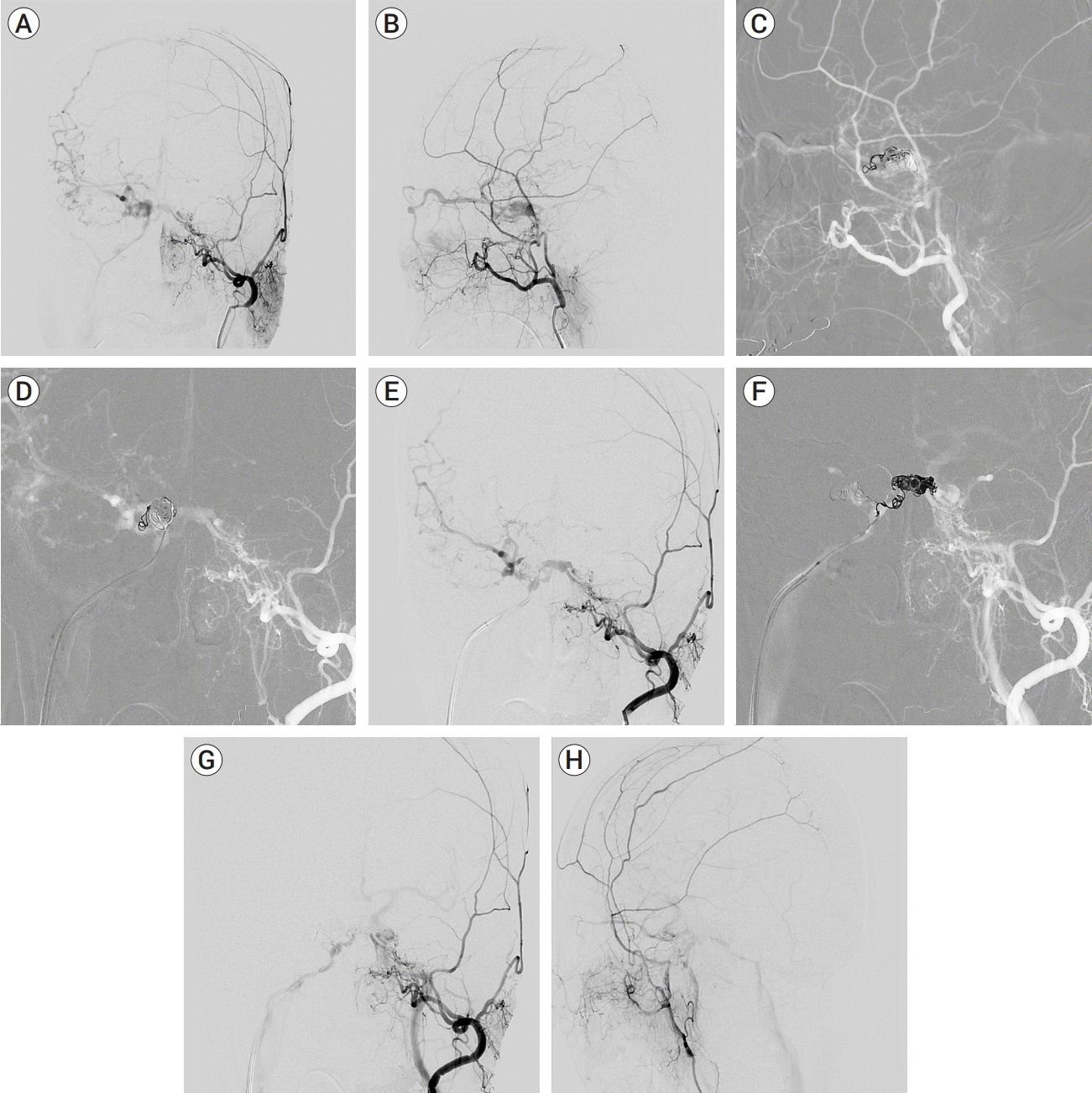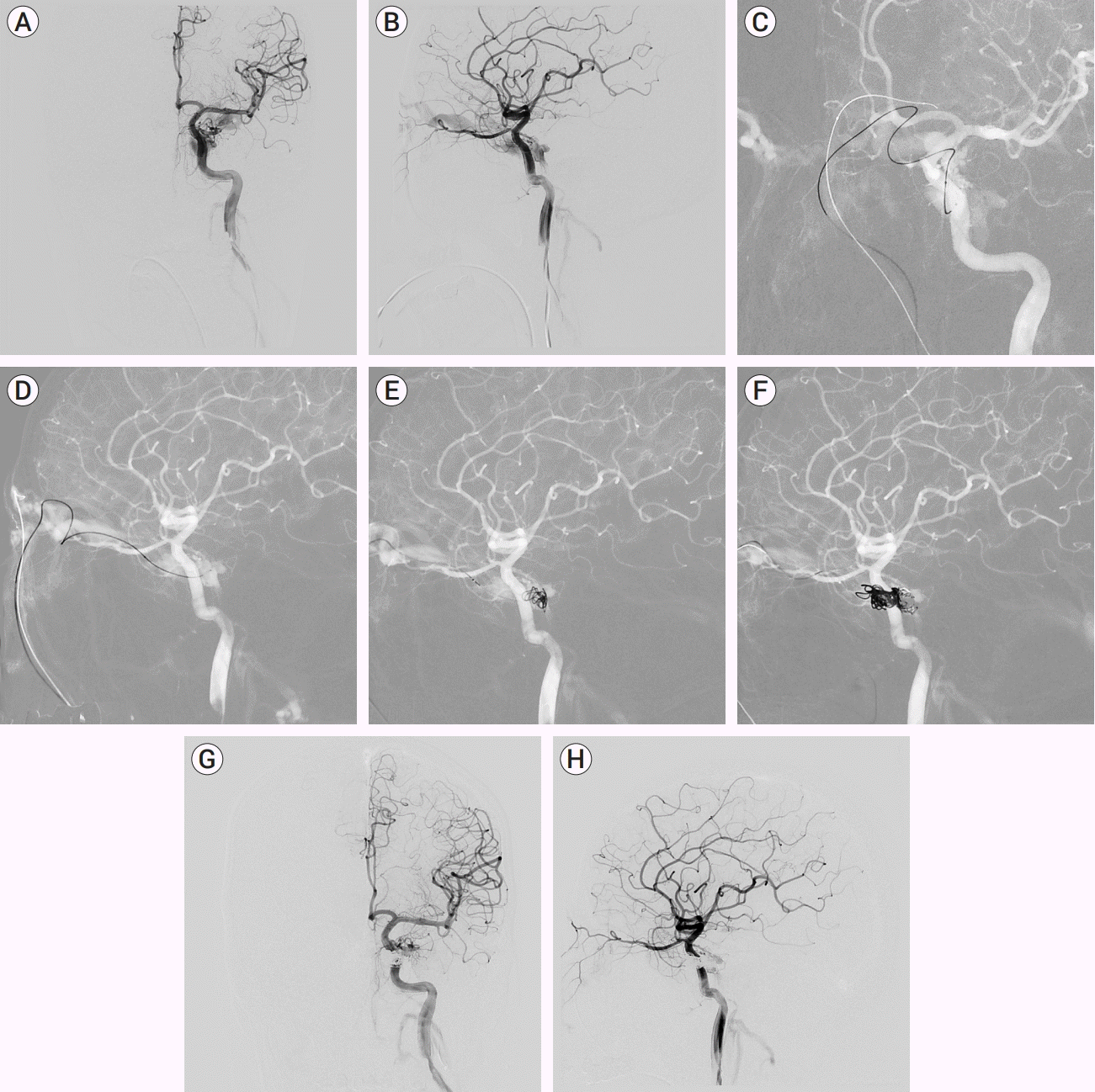1. Akamatsu Y, Sato K, Endo H, Matsumoto Y, Tominaga T. Single-session hematoma removal and transcranial coil embolization for a cavernous sinus dural arteriovenous fistula: A technical case report. World Neurosurgery. 2017; Aug. 104:1046.

2. Barcia-Salorio JL, Soler F, Barcia JA, Hernández G. Stereotactic radiosurgery for the treatment of low-flow carotid-cavernous fistulae: results in a series of 25 cases. Stereotactic and Functional Neurosurgery. 1994; 63(1-4):266–70.

3. Barrow D. Cavernous sinus dural arteriovenous malformations. Dural Arteriovenous Malformations. 1993; 117–30.
4. Bellon RJ, Liu AY, Adler JR, Norbash AM. Percutaneous transfemoral embolization of an indirect carotid-cavernous fistula with cortical venous access to the cavernous sinus. Journal of Neurosurgery. 1999; May. 90(5):959–63.

5. Benndorf G, Campi A. Aberrant inferior petrosal sinus: unusual transvenous approach to the cavernous sinus. Neuroradiology. 2002; Feb. 44(2):158–63.

6. Brooks B. Discussion of Noland and Taylor. Trans South Surg Assoc. 1931; 43:176–7.
7. Brown JA, Pilitsis JG. Percutaneous balloon compression for the treatment of trigeminal neuralgia: results in 56 patients based on balloon compression pressure monitoring. Neurosurgical Focus. 2005; May. 18(5):E10.

8. Chaudhary N, Lownie SP, Bussière M, Pelz DM, Nicolle D. Transcortical venous approach for direct embolization of a cavernous sinus dural arteriovenous fistula: technical case report. Operative Neurosurgery. 2012; Jun. 70(suppl. 2):onsE343–8.

9. Cheng KM, Chan CM, Cheung YL. Transvenous embolisation of dural carotid-cavernous fistulas by multiple venous routes: a series of 27 cases. Acta Neurochirurgica. 2003; Jan. 145(1):17–29.

10. Cognard C, Gobin YP, Pierot L, Bailly AL, Houdart E, Casasco A, et al. Cerebral dural arteriovenous fistulas: clinical and angiographic correlation with a revised classification of venous drainage. Radiology. 1995; Mar. 194(3):671–80.

11. De Andrade GC, Alves H, Parente R, Salvarani CP, Clímaco VM, Pereira ER. Spontaneous isolated dural arteriovenous fistula of the cavernous sinus: endovascular approach via the foramen ovale: A technical note. Interventional Neuroradiology. 2012; Dec. 18(4):458–62.
12. Debrun GM, Viñuela F, Fox AJ, Davis KR, Ahn HS. Indications for treatment and classification of 132 carotid-cavernous fistulas. Neurosurgery. 1988; Feb. 22(2):285–9.

13. Fioravanti A, Fiaschi P, Badaloni F, Calbucci F. Transcranial approach for surgical-combined-endovascular treatment of a cavernous dural arteriovenous fistula: the superficial sylvian vein route. Journal of Neurosurgical Sciences. 2020; Aug. 64(4):405–7.

14. Geibprasert S, Pongpech S, Armstrong D, Krings T. Dangerous extracranial–intracranial anastomoses and supply to the cranial nerves: vessels the neurointerventionalist needs to know. American Journal of Neuroradiology. 2009; Sep. 30(8):1459–68.

15. Gemmete JJ, Ansari SA, Gandhi DM. Endovascular techniques for treatment of carotid-cavernous fistula. Journal of Neuro-Ophthalmology. 2009; Mar. 29(1):62–71.
16. Gil A, López-Ibor L, Lopez-Flores G, Cuellar H, Murias E, Rodríguez-Boto G. Treatment of a carotid cavernous fistula via direct transovale cavernous sinus puncture. Journal of Neurosurgery. 2013; Jul. 119(1):247–51.
17. Guglielmi G, Viñuela F, Briganti F, Duckwiler G. Carotid-cavernous fistula caused by a ruptured intracavernous aneurysm: endovascular treatment by electrothrombosis with detachable coils. Neurosurgery. 1992; Sep. 31(3):591–6.
18. Guo WY, Pan DH, Wu HM, Chung WY, Shiau CY, Wang LW, et al. Radiosurgery as a treatment alternative for dural arteriovenous fistulas of the cavernous sinus. American Journal of Neuroradiology. 1998; Jun-Jul. 19(6):1081–7.
19. Halbach VV, Higashida RT, Hieshima GB, Hardin CW, Pribram H. Transvenous embolization of dural fistulas involving the cavernous sinus. American Journal of Neuroradiology. 1989; Mar-Apr. 10(2):377–83.
20. Hamby WB. Carotid-cavernous fistula: report of 32 surgically treated cases and suggestions for definitive operation. Journal of Neurosurgery. 1964; Oct. 21(10):859–66.
21. Higashida RT, Halbach VV, Tsai FY, Norman D, Pribram HF, Mehringer CM, et al. Interventional neurovascular treatment of traumatic carotid and vertebral artery lesions: results in 234 cases. American Journal of Roentgenology. 1989; 153(3):577–82.

22. Hosobuchi Y. Electrothrombosis of carotid-cavernous fistula. Journal of Neurosurgery. 1975; Jan. 42(1):76–85.

23. Houdart E, Gobin YP, Casasco A, Aymard A, Herbreteau D, Merland JJ. A proposed angiographic classification of intracranial arteriovenous fistulae and malformations. Neuroradiology. 1993; 35(5):381–5.

24. Jahan R, Gobin Y, Glenn B, Duckwiler G, Vinuela F. Transvenous embolization of a dural arteriovenous fistula of the cavernous sinus through the contralateral pterygoid plexus. Neuroradiology. 1998; Mar. 40(3):189–93.

25. Kirsch M, Henkes H, Liebig T, Weber W, Esser J, Golik S, et al. Endovascular management of dural carotid–cavernous sinus fistulas in 141 patients. Neuroradiology. 2006; Jul. 48(7):486–90.

26. Klisch J, Huppertz HJ, Spetzger U, Hetzel A, Seeger W, Schumacher M. Transvenous treatment of carotid cavernous and dural arteriovenous fistulae: results for 31 patients and review of the literature. Neurosurgery. 2003; Oct. 53(4):836–56.

27. Kuwayama N, Endo S, Kitabayashi M, Nishijima M, Takaku A. Surgical transvenous embolization of a cortically draining carotid cavernous fistula via a vein of the sylvian fissure. American Journal of Neuroradiology. 1998; Aug. 19(7):1329–32.
28. Leibovitch I, Modjtahedi S, Duckwiler GR, Goldberg RA. Lessons learned from difficult or unsuccessful cannulations of the superior ophthalmic vein in the treatment of cavernous sinus dural fistulas. Ophthalmology. 2006; Jul. 113(7):1220–6.

29. Lewis AI, Tomsick TA, Tew Jr JM. Management of 100 consecutive direct carotid-cavernous fistulas: results of treatment with detachable balloons. Neurosurgery. 1995; Feb. 36(2):239–44.
30. Li MH, Tan HQ, Fang C, Zhu YQ, Wang W, Wang J, et al. Trans-arterial embolisation therapy of dural carotid–cavernous fistulae using low concentration n-butyl-cyanoacrylate. Acta Neurochirurgica. 2008; Nov. 150(11):1149–56.

31. Matsumoto A, Okauchi M, Shindo A, Kawanishi M, Tamiya T. Cavernous sinus dural arteriovenous fistula treated by facial vein direct puncture: Case report and review of the literature. Interventional Neuroradiology. 2017; Jun. 23(3):301–6.

32. Meyers PM, Halbach VV, Dowd CF, Lempert TE, Malek AM, Phatouros CC, et al. Dural carotid cavernous fistula: definitive endovascular management and long-term follow-up. American journal of ophthalmology. 2002; Jul. 134(1):85–92.

33. Michels KS, Ng JD, Falardeau J, Roberts WG, Petersen B, Nesbit GM, et al. Transvenous embolization of a dural carotid-cavernous sinus fistula via the inferior ophthalmic vein. Ophthalmic Plastic & Reconstructive Surgery. 2007; Nov-Dec. 23(6):480–2.

34. Mullan S. Treatment of carotid-cavernous fistulas by cavernous sinus occlusion. Journal of Neurosurgery. 1979; Feb. 50(2):131–44.

35. Nelson PK, Russell SM, Woo HH, Alastra AJ, Vidovich DV. Use of a wedged microcatheter for curative transarterial embolization of complex intracranial dural arteriovenous fistulas: indications, endovascular technique, and outcome in 21 patients. Journal of Neurosurgery. 2003; Mar. 98(3):498–506.

36. Parkinson D. A surgical approach to the cavernous portion of the carotid artery: anatomical studies and case report. Journal of Neurosurgery. 1965; Nov. 23(5):474–83.
37. Parkinson D. Lateral sellar compartment O.T. (cavernous sinus): history, anatomy, terminology. The Anatomical Record. 1998; Aug. 251(4):486–90.

38. Parkinson D. Transcavernous repair of carotid cavernous fistula: case report. Journal of Neurosurgery. 1967; Apr. 26(4):420–4.
39. Peeters FL, Kroger R. Dural and direct cavernous sinus fistulas. American Journal of Roentgenology. 1979; 132(4):599–606.

40. Pollock BE, Nichols DA, Garrity JA, Gorman DA, Stafford SL. Stereotactic radiosurgery and particulate embolization for cavernous sinus dural arteriovenous fistulae. Neurosurgery. 1999; Sep. 45(3):459–66.

41. Satomi J, Satoh K, Matsubara S, Nakajima N, Nagahiro S. Angiographic changes in venous drainage of cavernous sinus dural arteriovenous fistulae after palliative transarterial embolization or observational management: a proposed stage classification. Neurosurgery. 2005; Mar. 56(3):494–502.

42. Serbinenko FA. Balloon catheterization and occlusion of major cerebral vessels. Journal of Neurosurgery. 1974; Aug. 41(2):125–45.

43. Shi ZS, Qi TW, Gonzalez NR, Ziegler J, Huang ZS. Combined covered stent and onyx treatment for complex dural arteriovenous fistula involving the clivus and cavernous sinus. Surgical Neurology. 2009; Aug. 72(2):169–74.

44. Stiebel-Kalish H, Setton A, Nimii Y, Kalish Y, Hartman J, BarOn RH, et al. Cavernous sinus dural arteriovenous malformations: patterns of venous drainage are related to clinical signs and symptoms. Ophthalmology. 2002; Sep. 109(9):1685–91.

45. Suh DC, Lee JH, Kim SJ, Chung SJ, Choi CG, Kim HJ, et al. New concept in cavernous sinus dural arteriovenous fistula: correlation with presenting symptom and venous drainage patterns. Stroke. 2005; Jun. 36(6):1134–9.
46. Takahashi M, Tanaka M. Cavernous sinus venography by transfemoral catheter technique. Neuroradiology. 1971; Nov. 3(1):1–3.

47. Thomas AJ, Chua M, Fusco M, Ogilvy CS, Tubbs RS, Harrigan MR, et al. Proposal of venous drainage–based classification system for carotid cavernous fistulae with validity assessment in a multicenter cohort. Neurosurgery. 2015; Sep. 77(3):380–5.

48. Travers B. A case of aneurism by anastomosis in the orbit, cured by the ligature of the common carotid artery. Medico-Chirurgical Transactions. 1811; 2:1–420. 1.
49. Venturi C, Bracco S, Cerase A, Gennari P, Lorè F, Polito E, et al. Endovascular treatment of a cavernous sinus dural arteriovenous fistula by transvenous embolisation through the superior ophthalmic vein via cannulation of a frontal vein. Neuroradiology. 2003; Aug. 45(8):574–8.

50. Wakhloo AK, Perlow A, Linfante I, Sandhu JS, Cameron J, Troffkin N, et al. Transvenous n-butyl-cyanoacrylate infusion for complex dural carotid cavernous fistulas: technical considerations and clinical outcome. American Journal of Neuroradiology. 2005; Sep. 26(8):1888–97.
51. Wenderoth J. Proposal for an improved classification system for cavernous sinus dural arteriovenous fistula (CS-DAVF). Journal of Neurointerventional Surgery. 2017; Mar. 9(3):220–4.

52. Yu SC, Cheng HK, Wong GK, Chan CM, Cheung JY, Poon WS. Transvenous embolization of dural carotid-cavernous fistulae with transfacial catheterization through the superior ophthalmic vein. Neurosurgery. 2007; Jun. 60(6):1032–7.








 PDF
PDF Citation
Citation Print
Print



 XML Download
XML Download